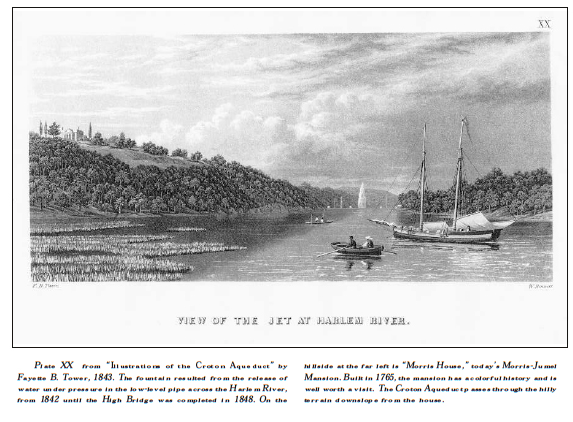
This year marks the 160th anniversary of the 1848 completion of the High Bridge. With last year’s Earth Day announcement by Mayor Bloomberg that the city will fund the bridge’s restoration and reopening as part of its PlaNYC 2030, there is now true cause for celebration. An interesting sidelight of High Bridge history is the jet of water that on occasion shot up from the Harlem River during the years of the bridge’s construction. The Croton Aqueduct opened in 1842; it was another six years until the bridge was completed. In the intervening years, Croton water was carried to Manhattan Island through a 36-inch low-level pipe laid across the river. The water descended on the mainland side and then ascended on the Manhattan side through a 120-foot-deep inverted siphon. The pressurized water, entirely gravity-fed, could be released as a jet, or fountain, upstream from the pipe crossing. According to Aqueduct historian Robert Kornfeld, Jr., the engineers would “play” the waters of the jet to varying effects, to the delight of High Bridge tourists. 
Fayette Tower, a young Aqueduct engineer, memorialized the feature with one of his classic illustrations (above). Here is part of his description:
“. . . an embankment has been formed across the River and the pipe leaving the Aqueduct on the north side of the valley follows down the slope of the hill, and crossing over the River upon this embankment, ascends on the south side again to the Aqueduct. At the bottom or lowest point in this pipe, a branch pipe of 1 foot diameter has been connected, extending a distance of 80 feet from it . . . the end of this pipe is turned upwards to form a jet, and iron plates are fastened upon it giving any form that may be desired to the water issuing. The level of this branch pipe is about 120 feet below the bottom of the Aqueduct . . . affording an opportunity for a beautiful jet d’eau; - such an [sic] one as cannot be obtained at the fountains in the city. From an orifice of seven inches diameter the column of water rises to a height of 115 feet when there is only a depth of 2 feet of water in the Aqueduct. . . . “The scenery around this fountain added much to its beauty; there it stood, - a whitened column rising from the river, erect, or shifting its form, or waving like a forest tree as the winds swayed it, with the rainbow tints resting upon its spray, while on either side the wooded hills arose to rival its height . . . “
Ever practical, John Jervis, Chief Engineer of the Aqueduct, in 1848 had the low pipe dismantled and moved onto the High Bridge, where it served permanently as one of the two original 36-inch pipes carrying Croton water across the river.

